When the crown and pavilion facets on a round brilliant diamond are in alignment (same index) and they are at similar angles for the respective opposing facets, then what could be seen in the pavilion of the diamond, when viewed from the crown are eight arrows. Any deviations in angles and indices within a facet group would have a visible effect on the symmetry of the arrows.
To understand this better we need to explore the geometry of polished diamonds (round brilliant), particularly the placement of facets and their respective angles. It should be the objective of any cutter to obtain maximum angular variance between facets. With that in mind we need to differentiate between angles and angles. Facet Definition is determined by the index (radial) and angular positions of facets.
Index (radial position or first element of facet definition)
Index refers to the radial position of facets. As an analogy, we can look at the example of a clock face as per the image below.
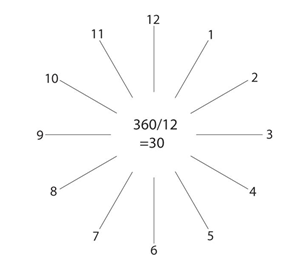
The face is divided into twelve equal parts. As there are twelve numeral positions, it follows logically that numerals are positioned in 30° increments (360÷12). The numerals are therefore representing their radial positions on the dial. If 12 is the datum (reference) 1 would be 30°, 2 would be 60° etc.
On diamonds, the radial positions (facet definition) are expressed in multiples of 11.25° (360÷32). To best illustrate this, let us take an example from a pizza.

If one cuts a pizza in half, it will have two segments (slices) of 180° each. If we quarter it, it will have 4 segments of 90° each. If we divide these 4 again, it will have 8 segments of 45° each. If we divide these 8 again, it will have 16 segments of 22.5° degrees each. Divide them one more time and it will have 32 segments of 11.25° degrees each. Now we have a picture that resembles the segments of a Round Brilliant diamond. On a Round Brilliant all the facets relate to one another in a radial position for a minimum of 11.25° or multiples of 11.25° i.e. 11.25 x 2 = 22.5° , 11.25 x 4 = 45°etc. on a well-cut diamond. The facet definition of a Round Brilliant is therefore a minimum of 11.25°, seen in a radial context. The following diagram would explain the radial position of the facets.
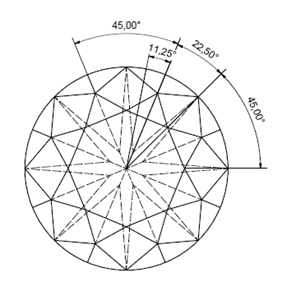
Angle (inclination, the second element of facet definition)
Angle refers to the inclination of facets in relation to the table facet. The table facet is the datum (reference) for the angles of the facets. Following is a diagram that shows the typical angles for well-defined arrows in Round Brilliant diamonds.
|
Crown and pavilion mains
|
Upper and lower
|
Star facets
|
Back to the arrows.
The arrows on well cut Round Brilliant diamonds is an optical phenomenon whereby the head of the viewer is obscuring the high angle light that should be reflected by the diamond. The AGS Aset system as well as the Ideal Scope captures this behavior in an effective way. In order to expand this a little further we need to look at the following diagram of a Round Brilliant.
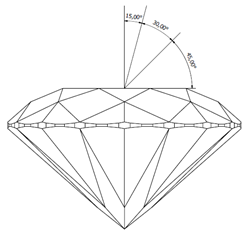
Light that reaches the diamond within the 15° (approximate) vector would normally be obscured by the head of the viewer. I say approximately 15°, but this could be greater if the viewer has big afro coiffure. This vector is normally rendered as blue. The next 30° vector, rendered as red, is referred to as high angle light. The next 45° vector rendered as green, represents low angle light. Think of the colors of the ASET and Ideal scopes as capturing overhead light as the sky (blue), red as the high sun and green as the surrounding trees and the horizon. The schematic in figure 7 is a simple 2D rendering. Visit the following websites for more information: https://www.americangemsociety.org/general/custom.asp?page=theagsaset1 and https://ideal-scope.com/
The arrows are therefore representing the amount of overhead light that is obscured by the viewer. There are four opposite sets of arrows on a well-cut Round Brilliant. This is touted by the jewelry industry as a valuable asset, as this creates a contrast with the rest of the facets that is somehow appealing.
Applying the same angular and index criteria to ovals, pears and marquise cut diamonds, then we get dark centers referred to as ‘bow ties.’ This is a very undesirable effect as the rest of diamonds are normally bright. In reality, we have a single bow tie in each of the fancies, but no one ever refers to the eight arrows in a Round Brilliant as four bow ties. It is one and the same thing, yet desirable in the one but not in the others.
Quite a number of years ago, an extremely gifted person started off-setting the main facets on the fancies mentioned, by aligning them with the indices of the star facets. This resulted in fancies with no bow ties, stunning appearance and optimized light return.
How to avoid bow ties
Fancy shaped diamonds could be cut according to the traditional method that will exhibit distinctive bow ties. The presence of a bow tie is not a sign of poor workmanship, but rather poor design. A diamond could be cut to extreme perfection yet have distinct bow ties. There are several ways to eliminate bow ties:
- For traditional ovals, lower the pavilion angle, which may lead to crushed ice effect
- For traditional ovals, increase the pavilion angle which will compromise light return
- Rotate the pavilion mains to line up with the star facets
- Cut four pavilion mains to coincide with the wing facets, to form a French culet
The afore mentioned is applicable to pear and marquise cuts as well.
|
Traditional oval –
|
Oval with rotated or
|
Oval with French culet –
|
Following are ASET images of fancies with bow ties provided by Brock Wilke RJ, Research Analyst – courtesy of American Gem Society.
|
|
|
|
How bow ties are caused
Diamond pavilion facets act as mirrors that reflect whatever they ‘see.’ They would therefore not only reflect light but also images in its surroundings. One of the most significant ‘things’ the diamond reflect is you, the viewer. So, the facets (mirrors) that reflect substantially linear to your visual axis will reflect your face. The facets that reflect oblique to the visual axis, will not reflect you face as it is pointing somewhere else. The pavilion main facets in the oval below will reflect the viewer, resulting in the ‘bow tie’ phenomenon. The boxes in the upper area indicate where simulated light beams enter and in the lower area the unboxed simulated light beams indicate where they exit.
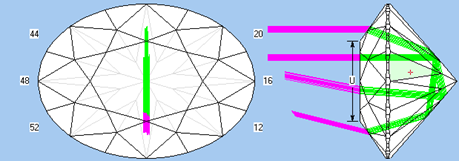
In the image below, we can see how the lower girdle facets reflect images/light, oblique to the line of sight. If the viewer is surrounded by light, the facets would reflect the light away from the viewer. They will therefore not ‘see’ the viewer and would not be part of a bow tie, unless the cutter did not create enough radial or angular definition, i.e. dug out the lower girdle facets.
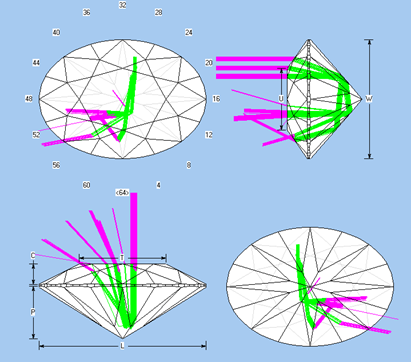
My personal favorite design is the rotated pavilion main in figure 9, as it allows for easier execution and best symmetry. The next best would be the French culet as in figure 10, which can be beautiful, but I have seen too many poorly cut fancies in this category with terribly uneven girdles.


 RapNet Blog
RapNet Blog









![Diamonds 6[1][1]](/media/2120/diamonds-6-1-1.png)